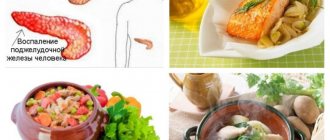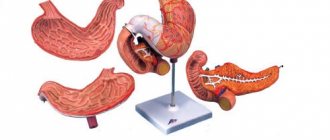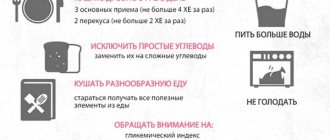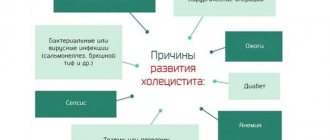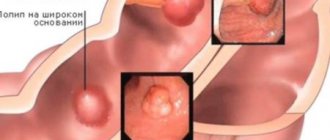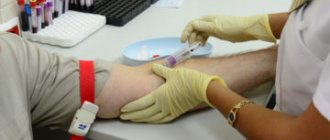This disease is treated by a Gastroenterologist.
Need more information?
Thank you for your request. Your application is accepted. Our specialist will contact you as soon as possible Dear patient, for all applications submitted from 22.00 to 07.00 we will contact you before 12.00 the next day. If your question is urgent, please call our 24/7 contact center +7
Need more information?
Did not find an answer to your question?
Leave a request and our specialists will advise you.
Thank you for your request. Your application is accepted. Our specialist will contact you as soon as possible Dear patient, for all applications submitted from 22.00 to 07.00 we will contact you before 12.00 the next day. If your question is urgent, please call our 24/7 contact center +7
By clicking on the button, you consent to the processing of your personal data
Thank you for your request. Your application is accepted. Our specialist will contact you shortly
A pathological condition characterized by inflammation of the pancreas tissue is called pancreatitis. Gastroenterologists and surgeons treat this disease.
Reasons for the development of pancreatitis
The most common cause of chronic pancreatitis is alcohol consumption, and the quality and raw materials from which the drink is made do not matter.
Other reasons
- Toxins and metabolic factors:
- alcohol abuse
- smoking
- increased calcium levels in the blood (develops in patients with a tumor of the parathyroid glands)
- overeating and eating fatty foods
- protein deficiency in food
- effects of medications and toxins
- chronic renal failure
- Blockage of the pancreatic duct:
- stones in this channel
- due to dysfunction of the sphincter of Oddi
- blocking of the duct by a tumor, cysts
- post-traumatic scars of the pancreatic ducts (complication of endoscopic procedures: papillosphincterotomy, stone removal, etc.)
- Pathology of the gallbladder and biliary tract.
- Pathology of the duodenum.
- Consequences of acute pancreatitis.
- Autoimmune mechanisms.
- Heredity (gene mutations, 1-antitrypsin deficiency, etc.).
- Helminths.
- Insufficient oxygen supply to the pancreas due to atherosclerosis of the vessels supplying blood to this organ.
- Congenital anomalies of the pancreas.
- Idiopathic chronic pancreatitis (the cause cannot be determined).
Causes of pancreatitis
The main mechanism for the formation of pancreatitis is the premature activation of digestive enzymes.
Normally, these substances are transported to the intestines in an inactive form, but in pathological conditions, enzymes begin to destroy the pancreas. Pathogenic microorganisms can migrate into the organ from other parts of the digestive system through the blood and lymph. Factors causing inflammation of the pancreas:
- Alcohol abuse;
- Cholelithiasis;
- Uncontrolled use of medications;
- Viral and bacterial infections;
- Smoking;
- High concentrations of triglycerides and calcium in the blood;
- Impaired immune system functions;
- Anatomical defects in which enzymes are delayed in the organ;
- Inflammation of the intestines and bile ducts;
- Abdominal injury;
- Malignant tumor of the pancreas.
The causes of acute and chronic pancreatitis may vary, but gastroenterologists always consider alcoholism and biliary tract diseases to be the main negative factors affecting the organ.
Symptoms of pancreatitis
- abdominal pain: usually the pain is localized in the epigastrium and radiates to the back, increasing after eating and decreasing when sitting or bending forward
- nausea, vomiting
- diarrhea, steatorrhea (fatty stool), increased stool volume
- bloating, rumbling in the stomach
- weight loss
- weakness, irritability, especially on an empty stomach, sleep disturbance, decreased performance
- the symptom of “red drops” is the appearance of bright red spots on the skin of the chest, back and abdomen.
If such symptoms appear, it is recommended to undergo examination to exclude chronic pancreatitis.
Symptoms of exacerbation of pancreatitis
Relapse begins with acute pain in the abdominal area, the localization of which is difficult to determine. In the absence of timely conservative therapy, the unpleasant feeling of pain only intensifies, the same thing happens after eating food and systematic overeating. To correctly differentiate exacerbation of pancreatitis, it is important to know its clinical manifestations:
- nausea, prolonged bouts of vomiting;
- vague feeling of pain, severe heartburn;
- rumbling, bloating, flatulence;
- severe signs of dyspepsia (weak stools, diarrhea);
- disruption of the endocrine system;
- increased body temperature, fever;
- dryness, bitterness in the mouth;
- lack of appetite, sudden weight loss;
- depression of the nervous system;
- nagging pain in the back of uncertain localization.
Complications of chronic pancreatitis
If left untreated, possible complications of chronic pancreatitis include:
- diabetes
- vitamin deficiency (mainly A, E, D)
- increased bone fragility
- cholestasis (with and without jaundice)
- inflammatory complications (inflammation of the bile ducts, abscess, cyst, etc.)
- subhepatic portal hypertension (fluid accumulation in the abdominal cavity, enlarged spleen, dilation of the veins of the anterior abdominal wall, esophagus, liver dysfunction)
- effusion pleurisy (fluid accumulation in the membranes of the lungs)
- compression of the duodenum with the development of intestinal obstruction
- pancreas cancer.
Prevention
Methods of primary prevention of chronic pancreatitis include:
- giving up alcohol, drawing up a rational menu and eating regimen, that is, developing an individual balanced diet with restrictions on fatty and carbohydrate foods;
- quitting cigarettes;
- drinking large amounts of water – at least 1.5 liters per day;
- sufficient inclusion of microelements and vitamins in the diet;
- timely visit to the doctor in case of disturbances in the gastrointestinal tract.
In order for disease prevention to be beneficial, you should adjust your diet and undergo a medical examination. Sanatorium-resort treatment also plays an important role in improving the condition of the disease.
- How pancreatitis manifests itself in childhood - symptoms and treatment of the disease
- The connection between pancreatitis and the development of diabetes mellitus: endocrine disorders and their consequences
Severity of chronic pancreatitis
There are three degrees of severity of chronic pancreatitis:
Mild degree
- exacerbations are rare (1-2 times a year), short-lived
- moderate pain
- no weight loss
- no diarrhea, no fatty stools
- Coprological examination of stool is normal (no neutral fat, fatty acids, soaps)
With mild severity of chronic pancreatitis, long courses of medication are usually not required, since lifestyle changes and giving up bad habits often prevent relapses.
Average degree
- exacerbations 3-4 times a year, occur with prolonged pain syndrome
- There may be an increase in amylase and lipase in the blood
- periodic loose stools, greasy stools
- there are changes in the coprogram
With moderate severity of chronic pancreatitis, a strict diet, longer courses of therapy, and constant supervision by the attending physician are necessary.
Serious condition
- frequent and prolonged exacerbations with severe, prolonged pain syndrome
- frequent loose stools, fatty stools
- loss of body weight, up to exhaustion
- complications (diabetes mellitus, pseudocysts, etc.)
In severe cases of chronic pancreatitis, constant maintenance therapy, stronger medications and a strict diet are required. Often, patients need careful monitoring not only by a gastroenterologist, but also by doctors of other specialties (endocrinologist, surgeon, nutritionist). Emerging exacerbations, as well as complications of the disease, pose a threat to the patient’s life and, as a rule, are an indication for hospitalization.
The presence of chronic pancreatitis, regardless of severity, requires immediate consultation with a doctor, since without treatment and lifestyle changes, the process will steadily progress.
Treatment
Treatment depends on the form of the disease, severity, presence of additional pathologies, age, and condition of the patient. Treatment of acute pancreatitis is carried out in a hospital setting - it is important to control the diet, the patient’s condition and to have the opportunity, if the condition worsens, to urgently perform surgical intervention (installation of drainage, removal of tissue subjected to necrotic changes).
As first aid, a ban on drinking and eating until the doctor arrives, bed rest (you can lie on your side or with your knees tucked in if this alleviates the symptoms), and a cold compress that inhibits inflammation. Elimination of exacerbation is impossible without the use of drugs from different drug groups (selected by a doctor after examination):
- antispasmodics, painkillers, anticholinergics;
- blockers of enzyme production that provoke the development of necrotic processes;
- cytostatics to relieve inflammation;
- antibiotics when a bacteriological infection occurs;
- drugs for intoxication of the body + electrolyte solutions.
Treatment of the chronic form is carried out at any stage (remission/exacerbation). During remission, a person is prescribed enzymes that are not enough for normal digestion. Additionally, medications are prescribed that enhance intestinal motility, restore pH and vitamin balance (vitamins A, B, C, D, K, E). According to indications, cocarboxylase and lipoic acid are prescribed.
Treatment is complemented by an appropriate diet; in case of exacerbation of the chronic form, a two-day fast is sometimes prescribed. A special diet and a list of prohibited foods are being developed. If you have a chronic form, this list will need to be followed for life to avoid relapses.
Diagnosis of pancreatitis
The EXPERT Clinic has an algorithm for diagnosing chronic pancreatitis, which includes:
Laboratory methods:
- A clinical and biochemical blood test is performed (of particular importance is the level of pancreatic enzymes in the blood - amylase, lipase)
- coprogram - the presence of certain substances in the stool (fats, soaps, fatty acids, etc.) is assessed. Normally, they should be absent, but in chronic pancreatitis, due to insufficient production of enzymes by the gland to break down these substances, they remain undigested and are detected in the feces
- fecal elastase is an enzyme of the pancreas, the level of which decreases when it is not working enough
- in certain cases, it is important to determine cancer markers
- If a hereditary genesis of the disease is suspected, a genetic examination of the patient is carried out.
Instrumental studies
- Ultrasound of the abdominal cavity. Signs of inflammation of the pancreatic tissue, the presence of stones in the ducts, calcifications, cysts, and tumors of the pancreas are assessed. Additionally, changes in other organs of the gastrointestinal tract are determined to exclude complications of the disease, as well as concomitant pathologies.
- Elastography of the pancreas.
Allows you to determine whether there is fibrosis (hardening) of the pancreas, which is a criterion for the severity of structural changes in the organ. Ultrasound with elastography of a healthy pancreas - FGDS. Visualization of the duodenum is necessary to assess the presence of inflammation in it, as well as indirect signs of pancreatitis. It is necessary to exclude inflammation and pathological formations (tumor, diverticulum) in the area of the large duodenal nipple (through it, pancreatic secretions enter the duodenum; when it is blocked, the outflow of this secretion is disrupted, which leads to inflammation of the gland tissue). Visualization of the stomach and esophagus is necessary to exclude erosions, ulcers, and inflammation in them. Pathological changes in these organs are often combined with chronic pancreatitis, being mutually aggravating conditions.
- Additionally, CT and MRI of the abdominal cavity with cholangiography and RCHP may be prescribed. They are necessary to confirm the diagnosis, and are also prescribed if there is a suspicion of the presence of pathological formations in the pancreas, blockage of the gland ducts with a stone, tumor or cyst.
Etiology
The main causes of the chronic form are alcohol abuse, as well as the development of cholelithiasis.
Alcohol poisons the parenchyma in the pancreas. And with cholelithiasis, the inflammatory process occurs as a consequence of the penetration of infectious bacteria from the bile ducts into the gland located along the vessels of the lymphatic system. This is how hypertension of the bile ducts occurs and it is thrown inside.
Additional risk factors include:
- increasing the content of calcium ions in the circulatory system;
- cysts;
- too much fat in the bloodstream;
- use of certain medications;
- autoimmune form of the disease; hereditary forms.
Treatment of pancreatitis
The main treatment for chronic pancreatitis is diet and giving up bad habits, lifestyle changes, as well as medications:
- drugs that reduce the production of hydrochloric acid by the stomach (proton pump inhibitors)
- enzyme preparations
- antispasmodics
- in the presence of pain - analgesics, NSAIDs; if the pain is extremely severe and is not eliminated by these drugs, narcotic analgesics are prescribed.
It is necessary to identify during the initial examination the pathology of other organs of the gastrointestinal tract (cholelithiasis, chronic cholecystitis, gastritis, duodenitis, peptic ulcer, hepatitis, bacterial overgrowth syndrome, intestinal dysbiosis, kidney disease, etc.), since these diseases may be the cause and/or aggravating factors of chronic pancreatic inflammation. In this case, treatment of other gastrointestinal diseases is necessary. The decision on the urgency and procedure for treating a particular concomitant disease is made by the attending physician.
If medications taken by a patient for other diseases may contribute to the development of the disease, the issue of replacing medications is decided.
All types of drug therapy should be prescribed and monitored by a gastroenterologist.
If any mechanical obstruction to the outflow of bile is detected, surgical treatment is indicated for the patient.
Treatment process
Treatment of chronic pancreatitis is carried out conservatively in accordance with the stage of organ damage, as well as depending on developing complications.
Conservative treatment consists of the following methods:
- Diet therapy. It is needed for all patients with chronic forms, especially after attacks. In this case, you must permanently give up any alcoholic beverages. You also need to exclude spicy, sour, and fatty foods from your diet. If you are accompanied by diabetes, you will also need to give up sweets.
- An attack of chronic pancreatitis is corrected according to the principle of acute forms - this is symptomatic treatment, pain relief, stopping the spread of inflammation, restoring the functioning of the digestive system.
Indications for surgical intervention are:
- purulent complication;
- blockage of bile ducts;
- sphincter stenosis;
- pronounced serious dysfunctions of tissues in the pancreas;
- cysts in the pancreas;
- severe course of the disease that does not respond to conservative therapy.
Forecast
Chronic pancreatitis is a serious disease. However, if you follow the recommendations of the supervising physician for the prevention of exacerbations (compliance with dietary recommendations, preventive courses of treatment, etc.), chronic pancreatitis proceeds “calmly”, without frequent exacerbations and has a favorable survival prognosis.
If the diet is violated, alcohol intake, smoking and inadequate treatment, degenerative processes in the gland tissue progress and severe complications develop, many of which require surgical intervention and can be fatal.
Signs of development
Often, initial disorders in the pancreas do not manifest themselves at all or may be expressed too weakly. This is what makes pancreatitis dangerous, because with the first attack, as a rule, the disease has already entered the advanced stage.
Note! As the disease progresses, the frequency of attacks increases. Chronic inflammation provokes damage to both the gland and external tissues. But for some patients, years pass before they receive their diagnosis.
During a visual examination, the doctor notes yellowing of the sclera and skin in patients with chronic forms.
Prevention and recommendations
Prevention is based on eliminating risk factors that provoke the disease:
- timely treatment of diseases that provoke pancreatitis
- eliminating the possibility of chronic intoxication that contributes to the development of this disease (industrial, as well as alcoholism)
- ensuring a balanced diet and daily routine.
Nutrition for chronic pancreatitis
For pancreatitis, all dishes are made from lean meat and fish - and then only in the boiled version. Fried foods are prohibited. You can consume dairy products with a minimum percentage of fat content. It is advisable to drink only natural juices, compotes and tea from liquids.
The following should be completely excluded:
- all types of alcohol, sweet (grape juice) and carbonated drinks, cocoa, coffee
- fried foods
- meat, fish, mushroom broths
- pork, lamb, goose, duck
- smoked meats, canned food, sausages
- pickles, marinades, spices, mushrooms
- white cabbage, sorrel, spinach, lettuce, radishes, turnips, onions, rutabaga, legumes, raw ungrated vegetables and fruits, cranberries
- pastries, black bread
- confectionery, chocolate, ice cream, jam, creams
- lard, cooking fats
- cold food and drinks
A qualified nutritionist will help you think through the basics of nutrition for chronic pancreatitis, create a diet and take into account the wishes and habits of the patient.
FAQ
Does the pancreas die in chronic pancreatitis?
Chronic pancreatitis is a disease characterized by inflammation and dystrophy with subsequent development of connective tissue in the organ and disruption of digestive and endocrine function. The “death” of the gland is called pancreatic necrosis and occurs in acute pancreatitis, being a deadly condition
Why does pancreatitis develop if I don’t drink?
Indeed, in most cases, the development of pancreatitis is caused by the effect of alcohol, but there are other factors: cholelithiasis, liver diseases characterized by impaired formation and outflow of bile, diseases of the stomach and duodenum, heredity, a malfunction in the immune system, impaired blood supply to the organ, background diseases: viral hepatitis, hemochromatosis, cystic fibrosis, etc.
Can pancreatitis be cured?
Chronic pancreatitis is called chronic because it cannot be completely cured, but correct medical tactics can achieve long-term remission.
Can pancreatitis lead to the development of diabetes?
Yes, a long course of pancreatitis can lead to the development of not only a violation of the digestive function of the pancreas, but also a change in the endocrine function with the development of diabetes mellitus, especially in the presence of a hereditary predisposition to diabetes mellitus.
Is it important to follow a diet for pancreatitis?
Diet is a fundamental factor in achieving remission.
general information
Pancreatitis is one of the most common diseases of the digestive system.
Acute inflammation of the pancreas can lead to destruction of organ tissue and disruption of vital functions. If not treated in a timely manner, the inflammatory process is complicated by a bacterial infection that can spread to other tissues. Usually the first symptom of the pathology is severe pain in the left hypochondrium, however, the chronic form of pancreatitis can have a hidden course. The pancreas is an important organ of the digestive system, necessary for the absorption of nutrients. This organ secretes enzymes that break down proteins, fats and complex carbohydrates in the intestines. Another function of the pancreas is endocrine regulation, which is necessary for the storage and use of glucose in the body. During acute inflammation, digestive enzymes are retained in the organ and begin to destroy tissue.
Treatment stories
Story No. 1
Patient X., 52 years old, came to the EXPERT Clinic with complaints of girdling pain after eating fatty foods and a small amount of alcohol, nausea, and loose stools. From the anamnesis it is known that discomfort in the area above the navel with loose stools was observed for several years due to dietary errors, but after following a strict diet they disappeared without a trace. The woman was not examined for this reason. This is the first time that real complaints have arisen. In addition, 20 years ago, during pregnancy, the patient was told about the presence of thick bile on ultrasound. The patient was not examined further, as nothing bothered her. During a laboratory and instrumental examination, changes in blood tests were revealed: increased ESR, pancreatic amylase activity, and ultrasound revealed multiple stones in the gall bladder. After pain relief, the patient was referred for planned surgical treatment - removal of the gallbladder. After a successful operation, the patient continues to be monitored by a gastroenterologist, follows dietary recommendations, has no complaints, and her indicators have returned to normal.
Story No. 2
Patient B., 56 years old, applied to the EXPERT Clinic with complaints of periodic intense pain syndrome of a shingles nature for no apparent reason, accompanied by nausea and diarrhea. At the previous stage of the examination, diffuse changes in the structure of the pancreas were identified, which was regarded as chronic pancreatitis. The patient led a healthy lifestyle, did not drink alcohol or fatty foods. The prescribed treatment with enzyme preparations did not have a significant effect. When trying to find out the cause of the development of pancreatitis, the gastroenterologist at the EXPERT Clinic ruled out a number of diseases that could lead to the development of chronic pancreatitis (gastrointestinal tract disease, peptic ulcer, iron metabolism disorder, etc.) and drew attention to an immunological shift in laboratory tests. This served as the basis for an in-depth immunological examination, which made it possible to establish that the cause of damage to the pancreas was a malfunction of the immune system - autoimmune pancreatitis. A pathogenetic treatment was prescribed that influenced the mechanism of development of the disease - glucocorticosteroids according to a regimen, against the background of which, during a control examination, the signs of immune inflammation were eliminated. Currently, the patient is receiving long-term maintenance therapy under the supervision of a supervisor and has no complaints. During control ultrasound of the abdominal organs, no signs of pancreatic edema were detected.
